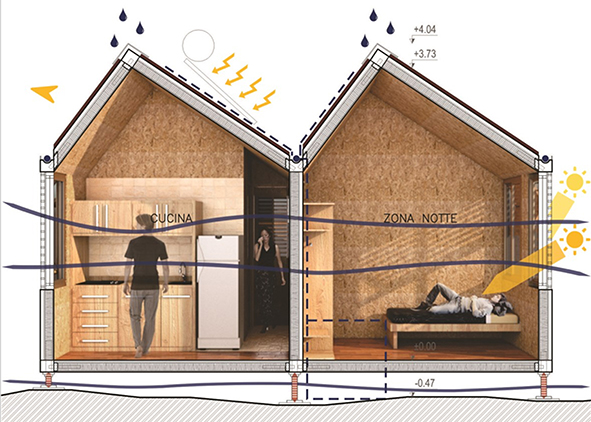New frontiers of temporary buildings. Passive housing modules
DOI:
https://doi.org/10.19229/2464-9309/4202018Keywords:
temporary buildings, emergency, technology, sustainability, versatilityAbstract
The purpose of this paper is to examine the characteristics of temporary buildings created to flexibly respond to the needs and necessities of people involved in natural disasters or in hardship cases. Architecture technology allows an industrialized modular low-cost building system, in case of an emergency – the ease and speed of the assembling process, flexibility, and immediate use – and the conditions of temporality: to create a light, removable, transportable, transformable, reusable and, at the same time, durable and adaptable to the territory’s climate and morphology building. It is a design proposal characterized by the use of passive systems which, by incorporating local resources, and recycled or recyclable materials, can guarantee the sustainability of the entire production process aiming to provide an efficient, quick and low-cost response, without neglecting architectural aspects, housing comfort and environmental impact.
Downloads
Article Metrics Graph
References
Baiocco, G. (2011), Ricerca per lo sviluppo di un modulo abitativo di emergenza sostenibile a carattere provvisorio, Tesi di Dottorato in Composizione Architettonica e Urbana, Dipartimento di Progettazione e Studio dell’Architettura, Università degli studi Roma Tre.
Bennicelli Pasqualis, M. (2014), Case temporanee, FrancoAngeli, Milano.
Bologna, R. and Terpolilli, C. (eds) (2005), Emergenza del Progetto – Progetto dell’Emergenza, Federico Motta editore, Milano.
Cascone, S. M., Caporlingua, M., Russo, G. and Tomasello, N. (2018), “La prefabbricazione per l’emergenza: excursus storico dalla nascita alle moderne applicazioni”, in D’Agostino, S. and d’Ambrosio, F. R. (eds), Atti del VII Convegno internazionale Storia dell’Ingegneria, Cuzzolin Editore, Napoli, pp. 597-605.
Curtis, J. R. (1999), L’architettura moderna dal 1900, Bruno Mondadori, Milano.
D’Auria, A. (2014), Abitare nell’emergenza, progettare per il post disastro, Edifir edizioni.
Masotti, C. (2010), Manuale di architettura d’emergenza e temporanea, Esselibri Simone, Napoli.
Pourtois, J. (2010), Architettura e nomadismo in XXI secolo – Gli spazi e le arti, Istituto della Enciclopedia Italiana Treccani, Roma.

Downloads
Published
How to Cite
Issue
Section
License
This Journal is published under Creative Commons Attribution Licence 4.0 (CC-BY).
License scheme | Legal code
This License allows anyone to:
Share: copy and redistribute the material in any medium or format.
Adapt: remix, transform, and build upon the material for any purpose, even commercially.
Under the following terms
Attribution: Users must give appropriate credit, provide a link to the license, and indicate if changes were made; users may do so in any reasonable manner, but not in any way that suggests the licensor endorses them or their use.
No additional restrictions: Users may not apply legal terms or technological measures that legally restrict others from doing anything the license permits.
Notices
Users do not have to comply with the license for elements of the material in the public domain or where your use is permitted by an applicable exception or limitation.
No warranties are given. The license may not give users all of the permissions necessary for their intended use. For example, other rights such as publicity, privacy, or moral rights may limit how you use the material.


















































































